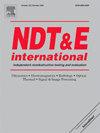Localisation of defects on carbon fibre surfaces using deep learning
IF 4.5
2区 材料科学
Q1 MATERIALS SCIENCE, CHARACTERIZATION & TESTING
引用次数: 0
Abstract
This study explores the application of deep learning for localisation and classification of common defects in carbon fibre materials. A Sony IMX250MZR polarisation camera was employed to leverage the polarising properties of CFRP surfaces. However, analysis revealed that the additional polarisation data provided minimal advantages. Instead, promising results were obtained using a standard monochrome output from the sensor. Defects were classified into two categories: “carbon fibre defects” and “foreign bodies”. A dataset comprising of 2400+ annotated instances for each type was analysed using two state-of-the-art deep learning models: YOLOv11-seg,for instance segmentation, and SegFormer for pixel-wise classification. Images were captured under three different illumination conditions including specialised dome lighting and strip lights in ambient environments. Each lighting configuration yielded promising results, with dome lighting demonstrating superior performance. YOLOv11 achieved an average precision score of 0.817 under dome lighting, compared to 0.672 in the least favourable lighting scenario. SegFormer slightly outperformed YOLOv11 in segmentation accuracy, achieving a mean Intersection over Union (mIoU) of 0.742 compared to 0.678 for YOLOv11. The consistently high detection rates demonstrate the potential of both models for reliable identification of critical and minor defects, making them well-suited for industrial quality assurance.
碳纤维表面缺陷的深度学习定位
本研究探讨了深度学习在碳纤维材料常见缺陷定位和分类中的应用。使用索尼IMX250MZR偏振相机来利用CFRP表面的偏振特性。然而,分析显示,额外的极化数据提供了最小的优势。相反,使用传感器的标准单色输出获得了有希望的结果。缺陷被分为两类:“碳纤维缺陷”和“异物”。使用两种最先进的深度学习模型分析了由每种类型的2400多个带注释的实例组成的数据集:YOLOv11-seg用于实例分割,SegFormer用于逐像素分类。图像是在三种不同的照明条件下拍摄的,包括特殊的圆顶照明和环境中的条形灯。每种照明配置都产生了令人鼓舞的结果,其中圆顶照明表现出卓越的性能。YOLOv11在圆顶照明下的平均精度得分为0.817,而在最不利的照明场景下为0.672。SegFormer在分割精度上略优于YOLOv11,实现了0.742的平均交联(Intersection over Union, mIoU),而YOLOv11为0.678。始终如一的高检测率证明了这两种模型在可靠识别关键和次要缺陷方面的潜力,使它们非常适合工业质量保证。
本文章由计算机程序翻译,如有差异,请以英文原文为准。
求助全文
约1分钟内获得全文
求助全文
来源期刊

Ndt & E International
工程技术-材料科学:表征与测试
CiteScore
7.20
自引率
9.50%
发文量
121
审稿时长
55 days
期刊介绍:
NDT&E international publishes peer-reviewed results of original research and development in all categories of the fields of nondestructive testing and evaluation including ultrasonics, electromagnetics, radiography, optical and thermal methods. In addition to traditional NDE topics, the emerging technology area of inspection of civil structures and materials is also emphasized. The journal publishes original papers on research and development of new inspection techniques and methods, as well as on novel and innovative applications of established methods. Papers on NDE sensors and their applications both for inspection and process control, as well as papers describing novel NDE systems for structural health monitoring and their performance in industrial settings are also considered. Other regular features include international news, new equipment and a calendar of forthcoming worldwide meetings. This journal is listed in Current Contents.
 求助内容:
求助内容: 应助结果提醒方式:
应助结果提醒方式:


